#Fernão
Explore tagged Tumblr posts
Text
As oportunidades são para candidatos de nível médio e superior; confira os detalhes Concursos › Notícias › Sudeste EDITAL DE ABERTURA Nº 004/2022 PROVAS RELACIONADAS PCI Concursos
0 notes
Text
always hate when im looking at a historical figure's wikipedia page and i can tell exactly what kind of person wrote it
#right now this is about fernão mendes's wikipedia page in portuguese specifically but it applies to a lot of things#and boy does it apply to the pages for a lot of pt historical figures from the 15-17th centuries
2 notes
·
View notes
Photo








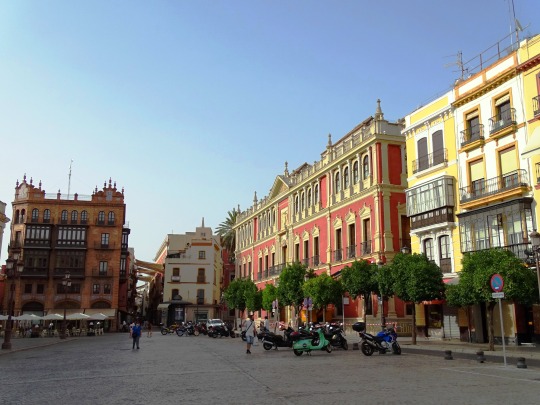

Ferdinand Magellan's five ships set sail from Seville to circumnavigate the globe on August 10 1519.
#Ferdinand Magellan#set sail#Fernão de Magalhães#Seville#10 August 1519#anniversary#Spanish history#Portugese history#Padrão dos Descobrimentos#Monument of the Discoveries#Cottinelli Telmo#Lisbon#Lisboa#Portugal#Sevilla#Seville Cathedral#Andalusia#white colonialism#tourist attraction#landmark#España#Spain#original photography#architecture#cityscape#summer 2021#vacation#travel#Southern Europe
3 notes
·
View notes
Text

Fernão Teles de Meneses, Retrato de Luís de Camões (1581)
1 note
·
View note
Text
“Just In Casings”
© EricBrazier.com

View On WordPress
#dapper#Funchal#green#hats#La Casa de las Carcasas#Madeira#people#phone cases#Portugal#Rua Dr. Fernão de Ornelas#street scene#Streetphotography#the old skippers#travel
1 note
·
View note
Text
Gramáticas Prescritiva, Descritiva e Internalizada: Compreendendo os Diferentes Enfoques na Língua Portuguesa
Desde a publicação da primeira gramática da língua portuguesa em 1536 por Fernão de Oliveira, em Lisboa, a relação entre língua e gramática tem sido objeto de reflexão e debate constante. No entanto, ao longo dos séculos, essa relação evoluiu e diversificou-se, levando ao desenvolvimento de diferentes concepções de gramática que refletem distintas abordagens sobre a língua portuguesa. A…

View On WordPress
#Aquisição da Linguagem#Competência Linguística#Compreensão da Língua#Criatividade Linguística#Desempenho Linguístico#Educação Linguística#Ensino de Português#Estrutura Linguística#Fenômenos Linguísticos#Fernão de Oliveira#Gerativismo#Gramática Descritiva#Gramática Internalizada#Gramática Normativa#Gramática Prescritiva#Intuição do Falante#Língua Portuguesa#Norma-Padrão#Normas Gramaticais#Significado Linguístico#Teoria Linguística#Variação Linguística#variações linguísticas#Variedade Linguística
0 notes
Text
Mountain bike infantil ganha força com o Bike Kids Cup
Bike Kids Cup levará mais de 300 crianças de várias partes do país para o Parque Fernão Dias, em Contagem, no próximo dia 19 de agosto

View On WordPress
0 notes
Text
Acidente entre ônibus e carreta deixa 6 feridos na BR-381 próximo ao trevo de Perdões, veja fotos
Neste último sábado (29/07) por volta das 09h15, um acidente na BR-381, no km 663, próximo ao Trevo de Perdões, mobilizou equipes de resgate e atendimento emergencial. Um ônibus, que seguia do Estado da Bahia para São Paulo, colidiu na traseira de uma carreta, resultando em danos materiais e lesões leves aos passageiros. O Corpo de Bombeiros de Oliveira, o Serviço de Atendimento Móvel de…

View On WordPress
0 notes
Text
Character Name Ideas that Start With the Letter F
-> feel free to comment suggestions, I'll do my best to add them to the list.

Male:
Finnian
Felix
Ferdinand
Fletcher
Fabian
Franklin
Fraser
Flynn
Ford
Foster
Fitzroy
Farley
Freeman
Fordham
Frederic
Fitzhugh
Frank
Filepe
Finnegan
Freddie
Forrest
Falcon
Fernão
Fenix
Fedor
Fritz
Fischer
Franco
Florencio
Filomeno
Fidel
Fortune
Fukashi
Farrell
Finneas
Falken

Female:
Felicity
Fiona
Florence
Faye
Francesca
Fallon
Farrah
Fleur
Frida
Fauna
Fernanda
Francine
Flora
Finola
Freedom
Faith
Farah
Fannie
Fiadh
Fatima
Fia
Floella
Finlee
Flor
Fausta
Ferna
Fae
Florella
Fidella
Franciszka
Francyne
Florie
Filomena
Floris
Faiza
Florencia
Francetta
Feleicia
Ferran
Fallen
Freesia
Fate

Gender Neutral:
Finley
Fable
Flynn
Fox
Forest
Frankie
Fifer
Fern
Finch
Faron
Fallon
Frey
Frost
Faelan
Flux
Firth
Fen
Fallow
Fikri
Fiore
Fadi
Frye
#character names#character name ideas#name ideas#name suggestions#name list#character name analysis#oc names#ocs#oc name ideas#writeblr#original character#creative writing
349 notes
·
View notes
Photo

Ferdinand Magellan
Ferdinand Magellan, or Fernão de Magalhães (c. 1480-1521), was a Portuguese mariner whose expedition was the first to circumnavigate the globe in 1519-22 in the service of Spain. Magellan was killed on the voyage in what is today the Philippines, and only 22 of the original 270 crew members made it back to Europe.
Continue reading...
86 notes
·
View notes
Text

The Parish Church of Borba, also known as Church of Our Lady of Soveral (or Our Lady of the Snow), a temple originally built circa 1420 and rebuilt circa 1560.
This church was built on the exact place where once existed a cork oak forest; according to a local legend, an image of the Virgin Mary miracolously appeared in this wood on the outskirts of Borba. The construction of the new Parish Church (that replace and old temple from 1260, that existed inside the castle walls) was ordered by the master of the Military Order of Saint Benedict of Avis, Fernão Rodrigues de Sequeira.
#Parish Church of Borba#Igreja Matriz de Borba#Church of Our Lady of Soveral#Igreja de Nossa Senhora do Soveral#Borba#Século XV#Siglo XV#XV Century#Alentejo Central#Alentejo#Alto Alentejo#Portugal#Original photo#photography#photographers on tumblr
21 notes
·
View notes
Text
Dando no carro (28-dez-2024)
By; Luany
Oi me chamo Luany. Tenho 19 anos, desde já agradeço por postarem. Sou de uma cidade perto de São Paulo, moro com meus pais e mais 2 irmãos.
Pra mim, a melhor coisa do mundo é ter um namorado mais velho e bem independente. Meus pais gostam muito dele e me deixam perambular de carro com ele. Algo dentro de carros e ruas movimentadas me excita de uma maneira inexplicável. Esse ar de lugar público e perigoso é um grande fetiche pra mim.
Era sábado à tarde quando recebi o convite do meu homem para jantar, um lugar excelente para se tomar uma cerveja e jogar conversa fora. Já que não tenho habilitação e não posso dirigir, quem me busca em casa é meu namorado.
Sem perceber, eu já vou na intenção de provocá-lo enquanto está dirigindo, porque sei que ele é muito inseguro no volante, tem medo de de bater.
Ao arrumar-me, depois de fazer depilação íntima, e deixar tudo arrumado, coloquei minha calcinha fio dental amarela de renda, minha favorita, e joguei por cima um vestido vermelho curtinho de manga comprida.
Ao chegar em minha casa e me ver impecável, já percebi que meu namorado estava excitado, por sentir seu pau duro ao me abraçar pelas costas. Me despedi de meus pais e pegamos o carro em direção à cidade.
Para chegar ao restaurante, precisamos pegar um pequeno trecho da Rodovia Fernão Dias. Meu namorado inseguro, na pista da direita, à sessenta quilômetros por hora, acariciava minha perna, subindo meu vestido involuntariamente.
Apoiei minha perna próximo ao painel do carro, exibindo minha calcinha, minhas coxas, seguido da canela, tornozelo e o pé que estava calçando um belo salto preto. Sentia que estava fazendo meu namorado quase perder o controle do carro diversas vezes. E isso ia me excitando cada vez mais. Ao perceber que ele estava desconcentrado, olhei para ele e disse:
- Quero ver você dirigir assim.
Imediatamente, curvei meu quadril pra cima, com as mãos tirei a calcinha, joguei-a para o banco de trás, apoiei a perna direita perto do vidro do passageiro e comecei a me masturbar. Enfiava dois dedos, depois três, olhava para ele e gemia. A desconcentração do meu namorado era tão grande que quase bateu o carro duas vezes, e perdeu o rumo de onde íamos.
Acabamos parando o carro em uma rua escura, um pouco movimentada. Passavam carros em alta velocidade, alguns passavam em baixa velocidade por curiosidade de ver o que estava acontecendo dentro deste carro parado no canto com os vidros embaçados, música alta que servia para disfarçar meus gemidos. Ele enfurecido, desligou o carro, tirou o cinto e me puxou pelo cabelo em sua direção. Apertava meus quadris com força enquanto me beijava enlouquecido.
Pulamos para o banco de trás. Ele disse que havia esquecido a camisinha no porta-luvas, então debrucei-me para os bancos da frente, me deixando com a bunda empinada. Quando estava abrindo o porta-luvas, levei um tapão, seguido de fortes beliscadas e mordidas.
- Sua cachorra! Quase batemos o carro por sua causa! Agora terá que aguentar as consequências. – Ele dizia, enquanto estapeava minha bunda, deixando-a vermelha e com marcas roxas.
Ao voltar pro banco de trás, tive a cabeça empurrada para baixo, e meu namorado me forçou a fazer aquele boquete, enfiando seu pau mais pra dentro da minha boca. Eu tossia, reclamava e sofria, mas era a vingança dele e, minha mania de gostar de ser submissa, obedecia a todos os comandos. Fui puxada pelo cabelo pra cima, minha boca estava toda melada. Seu desejo de me comer era tão grande que, me sentou em seu colo, até esqueceu a camisinha. Arrancou com tudo meu vestido e meu sutien, me deixando nua em seu carro.
Saí de seu colo, deitei-me no banco e abri as pernas, de modo que uma perna ficasse no encosto do banco da frente e a outra no encosto do banco de trás. Me surpreendi quando ele caiu de boca, mordia e chupava meu clitóris, e eu, enlouquecida puxava seu cabelo e gemia alto. Enfiava a língua e eu gritava.
Ele ergueu a cabeça, lambendo os beiços e disse:
- Tá gostoso? Vou deixar isso mais gostoso ainda.
Levantou, se ajoelhou na minha frente, e esfregava seu pau em meu clitóris, batia e depois me penetrou com força. A única reação que eu tive foi de cravar minhas unhas em suas costas e gritar de prazer. O jeito violento dele de querer meter com mais força, me fazia querer cada vez mais.
Na hora de gozar, ele tirou de dentro de mim e me forçou a chupá-lo, fazendo com que eu engolisse tudo. Depois nos vestimos depressa, Fomos a caminho do restaurante, trocando carícias, jantamos e depois ele me levou até em casa, já pensando qual será a próxima aventura.
Enviado ao Te Contos por Luany
11 notes
·
View notes
Text










Ferdinand Magellan's five ships set sail from Seville to circumnavigate the globe on August 10 1519.
#Ferdinand Magellan#set sail#Fernão de Magalhães#Seville#10 August 1519#505th anniversary#Spanish history#Portuguese history#Padrão dos Descobrimentos#Monument of the Discoveries#Cottinelli Telmo#Lisbon#Lisboa#Portugal#Sevilla#Seville Cathedral#Andalusia#white colonialism#tourist attraction#landmark#España#Spain#original photography#architecture#cityscape#summer 2021#vacation#travel#Southern Europe
1 note
·
View note
Text

Luís de Camões (c. 1524-1580), por Fernão Gomes
1 note
·
View note
Text
4 portuguese monarchs who might had same-sex relationships:
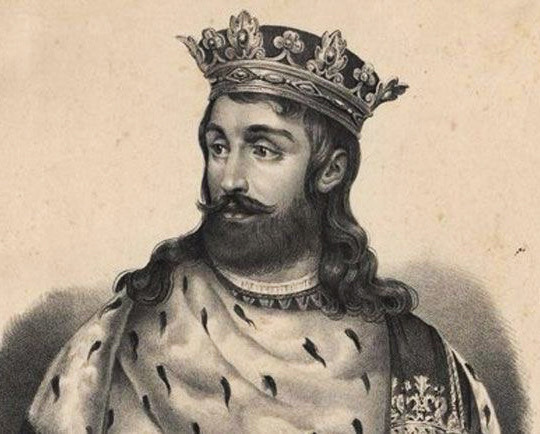
1) Pedro I of of Portugal, certainly, one if the most renowned portuguese monarchs, largely due to the saga of “love and passion” with Inês de Castro. Yet, it was common knowledge that she wasn't the Pedro’s only love: he harboured a passion for his squire, Afonso Moreira, a relationship that ended as disastrously as his other romantic (or not) entanglements. On one fateful occasion, Afonso was caught in bed with Catarina Tosse, wife of Lourenço Gonçalves, who was an esteemed magistrate.
Throughout his reign, Pedro earned the epithet “the Cruel” for his ruthless administration of justice, whereby transgressions of any magnitude often resulted in swift execution. Pedro’s decision to order Afonso’s castration as punishment for his adultery starkly manifested his merciless ethos. Nevertheless, according to Fernão Lopes, a chronicler of portuguese court at the time, in chapter VIII of “Crônica de el-rei D. Pedro I”, his harshness stemmed from a surge of jealousy on the king’s part upon discovering his beloved squire’s relationship with a woman.

2) Prince Henry, revered as “the Navigator”, occupies a central role particularly during the epoch of maritime exploration.
He was hailed as “chaste prince”, having never entered into wedlock, with no historical accounts suggesting (with certainty) any relationships with women. In the annals of 1444, Henry experienced the loss of a “dear friend” in Ceuta, a tragedy that pluged him into 3 months of profound mourning. Both his father, King John I, and his brother, King Edward, counselled him to “rein in his emotions, lest he indulge men beyond what virtue dictates.”
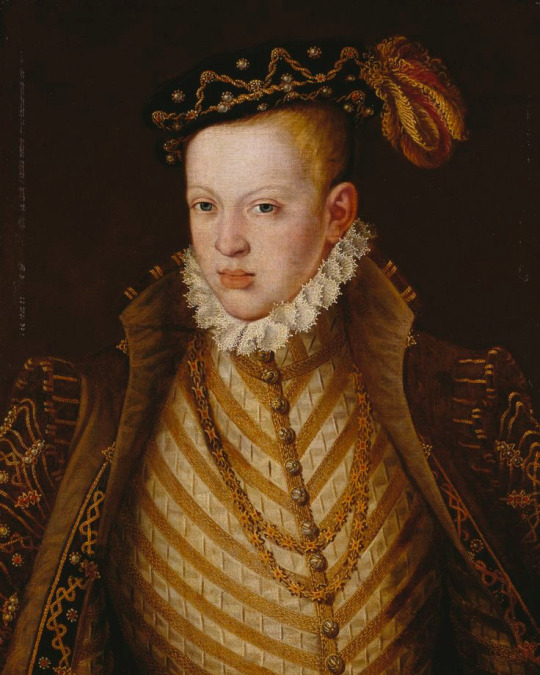
3) King Sebastian contracted gonorrhoea at the age 10/11, a malady documented in medical records at the time that rendered him sexually impotent. Some historians posit that this affliction may have dissuaded Sebastian from pursuing matrimonial unions or romantic relationships with women.
Even though, the “Crônicas de el-rei D. Sebastião” by Friar Bernardo da Cruz recounts an incident during a hunt in the Alentejo, where the entourage of nobles accompanying King Sebastian were stirred by a commotion. Investigating the disturbance, they stumbled upon the monarch locked in an embrance with a fugitive slave amidst the woodland.

4) King Afonso VI, sibling to Queen Catarina of Braganza, earned a reputation for rebeliouness and unruliness from a tender age, yet he harboured no ambitions for kingship.
His reign , marred by a series of missteps, was etched in history for its futile ventures. Despite grappling with severe health afflictions — such as partial paralysis stemming from hemiplegic fever, and scourge of bulimia — Afonso found solace in nocturnal escapades with his inner circle of friends. Among them was António Conti, an intalian peddler of opulent attire and accoutrements to Europe’s nobility. Conti’s sway in Afonso’s court burgeoned as he assumed the role of sartorial advisor and facilitator of introductions to foreign luminaries. Also, both grew increasingly closer to each other, with Afonso avoiding royal gatherings to spend time with Conti, mostly in his chambers.
In 1666, Afonso took the hand of Maria Francisca Isabel of Savoy, yet their union was fleeting. Maria, citing non-consummation owing to Afonso’s hemiplegia, sought an annulment. In letters to his sister, he bemoaned Maria’s coercive measures, by which she compelled him into relationships with 14 courtesants in a bid to unearth the root of their marital discord.
Seeking to shield Afonso’s sovereignty and secure the portuguese lineage, Luisa de Gusmão, his mother, sanctioned the arrest and subsequent exile of Conti to the distant shores of Brazil.
#i am sorry for how long it is#but i really wanted to post it#so there you have#theres other monarchs to talk about#but these are the ones with the most evidences#pedro i of portugal#prince henry#king sebastian#afonso vi of portugal#portugal#story time
18 notes
·
View notes
Text
Pedro & Inês (cultural ramblie)
Happy Valentine's Day!! <3<3 When I planned this post, I did not realize Carnaval and Valentine's Day were on consecutive days (catholic calendar calculations continue to kick my ass, just like every year), so you get TWO cultural ramblies for the price of one!!
This one is a bit different from the other ones. I usually talk about legends or holiday traditions but this is actually just history! Still, I felt inclined to share partly because this is a major thing in portuguese culture and partly because this is the most overdramatic historical anecdote I have ever seen and more people need to know about it. Now, let's get into it!
The Tragedy of Pedro and Inês


(portraits of Pedro and Inês, made centuries after their deaths)
In 1340, Prince Pedro of Portugal, son of King Afonso the 4th, married Constança Manuel of Aragon. When she moved to Portugal, Constança brought along her lady-in-waiting, Inês de Castro. You can already see where this is going.
Pedro and Inês fell madly in love and began a secret relationship (which seems to not have been that secret at all). In 1344, Afonso the 4th exiled Inês to the castle of Albuquerque, near the border, out of fear that this affair would sour diplomatic relationships with Castille.
It just so happens that Constança died in childbirth one year later. Despite his father's requests, Pedro refused to remarry, claiming that he was still too overcome with grief over his wife's death. Instead, he had Inês's exile annulled and began living with her. During this period in which they lived together, they had 4 children.
In 1355, five years later, King Afonso the 4th ordered the assassination of Inês de Castro. She was killed in Coimbra, in Quinta das Lágrimas, where legend says you can still hear her crying at the fountain where she lost her life, later named Fonte das Lágrimas ("Fountain of Tears"). This moment, along with another one further ahead, is the one all the poets go crazy for.
Inês's death triggered a revolt against the king, led by Pedro. However, there was never an actual physical confrontation, since the queen-mother was able to stop it in time.
In 1357, Pedro rose to the throne, becoming King Pedro the 1st. He claimed that he had married Inês in secret around 1354, legitimizing their children and making her possibly the only posthumous queen in history (someone fact-check me on this). For avenging her death, he was dubbed "Pedro, the Just".
He had matching tombs made for him and Inês so she could be buried as queen by his side. They still stand today in the Monastery of Alcobaça, where you can visit them. They were placed on opposite ends of the transept, facing each other, so that they could be face to face when they rose from their graves. The inscription on Pedro's tomb is thought to read "Until the ends of the world". I'll show pics later, don't worry.
You thought I was done? I haven't even gotten to the overdramatic part! (Ok, the tomb thing was pretty dramatic, but this part is extra as hell)
As King Pedro the 1st, he had Inês's two assassins executed. According to a somewhat contemporary chronicle by Fernão Lopes (still Middle Ages but a century later), he had their hearts ripped out, one through the chest and another through the back. Sources seem to disagree on whether this actually happened or not, but Fernão Lopes was a pretty reliable guy in other parts of his chronicle. And, this being strictly myth, it is said that he made those two assassins kiss the hand of Inês's corpse as they would the queen's. For this, he was dubbed "Pedro, the Cruel", on top of his other title. Perfectly balanced and whatnot.
Here's a painting by Pierre-Charles Comte about it:
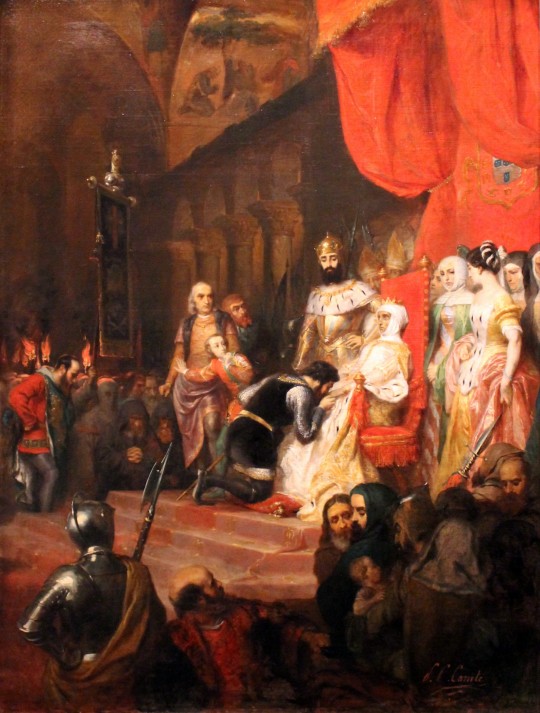
The Tombs
I saw them in early November of last year and I cannot overstate how amazing they are in real life. The whole church they're in is beautiful but the tombs are just breathtaking, especially knowing the story behind them.
They're the reason I wanted to make this post. They are considered some of the greatest masterpieces of portuguese gothic sculpture. They are full of intricate carvings and, despite missing a few pieces here and there, are still in amazingly good condition today. You can visit them for free any time.
Here are the pictures I promised. The last 2 are taken by me!


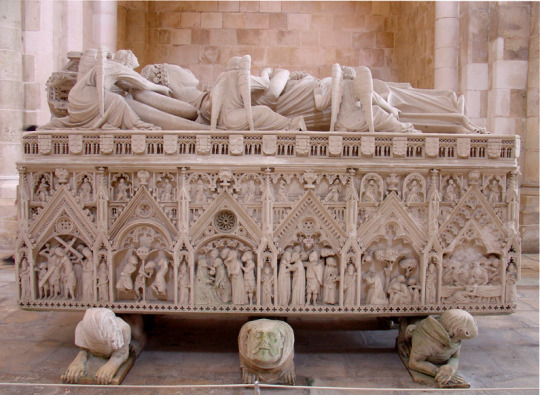
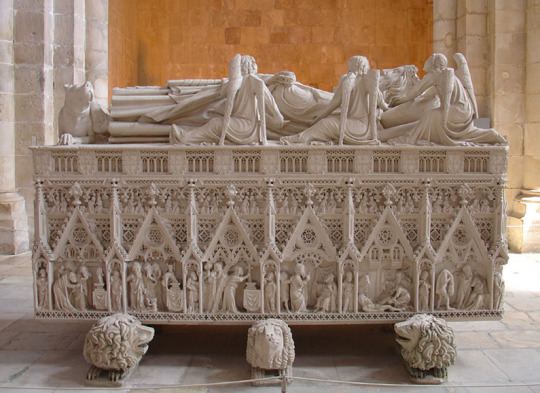
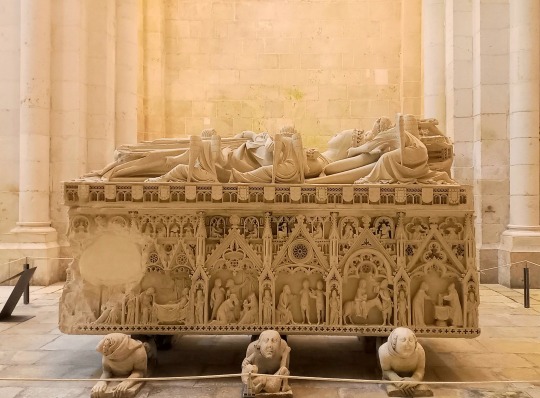

Some historical notes (cool facts)
This is mostly about the corpse coronation part because I found it in my research and thought it was cool.
The first dynasty of portuguese kings didn't have coronations. They were seen as warrior kings first and foremost, and therefore felt no need to pledge their allegiance to Christianity. If they did swear over something, it was a shield. They did not have the fancy ceremony.
What can we learn from all this, you ask?
Write that overdramatic romance you've been wanting to. You'll never out-drama queen King Pedro the 1st.
#as a kid i always felt really bad for Constança#she literally got pushed aside in the history she was a part of#no one cares about her???#all she is is “a woman who got cheated on”?? she deserves better!!!#anyways Pedro is the greatest drama queen to ever live#imagine being so extra about your girlfriend's death your tombs become some of the most famous sculptures in Portugal#and also the heart thing#the Middle Ages really were a time huh#portugal ramblies#portuguese history#portuguese legend#pedro e inês#happy valentine's day#<3 <3 <3#i'm not translating the names. fuck that.#i refuse to look up what the english equivalent of “Inês” is
9 notes
·
View notes